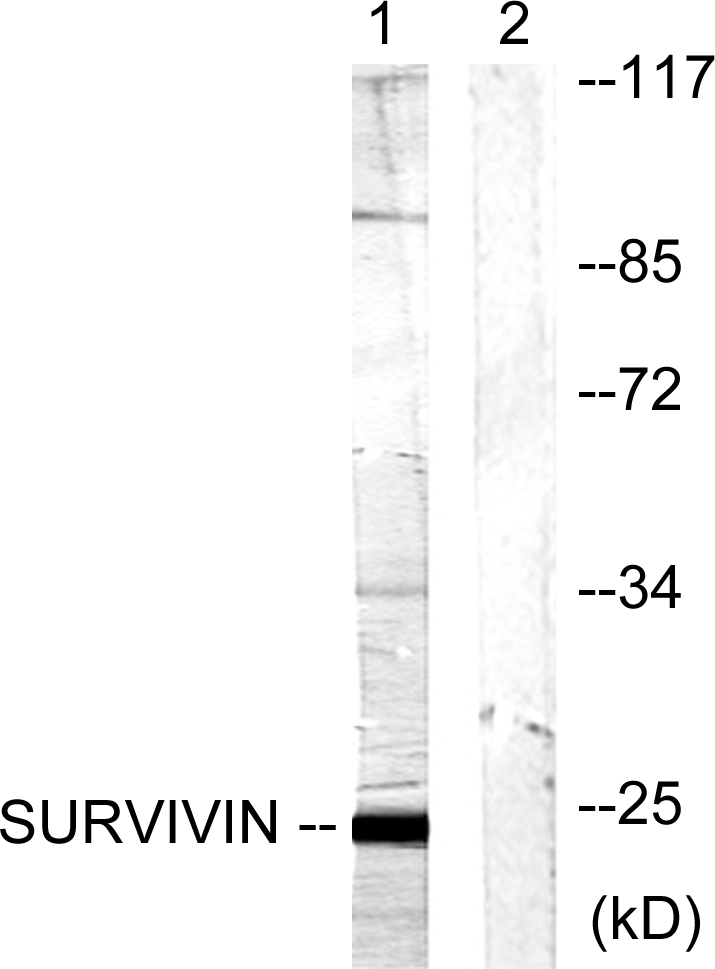Survivin antibody
GTX100052
ApplicationsImmunoFluorescence, ImmunoPrecipitation, Western Blot, ImmunoCytoChemistry, ImmunoHistoChemistry, ImmunoHistoChemistry Paraffin
Product group Antibodies
ReactivityHuman, Mouse
TargetBIRC5
Overview
- SupplierGeneTex
- Product NameSurvivin antibody
- Delivery Days Customer9
- Application Supplier NoteWB: 1:500-1:3000. ICC/IF: 1:100-1:1000. IHC-P: 1:100-1:1000. IP: 1:100-1:500. *Optimal dilutions/concentrations should be determined by the researcher.Not tested in other applications.
- ApplicationsImmunoFluorescence, ImmunoPrecipitation, Western Blot, ImmunoCytoChemistry, ImmunoHistoChemistry, ImmunoHistoChemistry Paraffin
- CertificationResearch Use Only
- ClonalityPolyclonal
- Concentration1 mg/ml
- ConjugateUnconjugated
- Gene ID332
- Target nameBIRC5
- Target descriptionbaculoviral IAP repeat containing 5
- Target synonymsAPI4, EPR-1, baculoviral IAP repeat-containing protein 5, apoptosis inhibitor 4, apoptosis inhibitor survivin
- HostRabbit
- IsotypeIgG
- Protein IDO15392
- Protein NameBaculoviral IAP repeat-containing protein 5
- Scientific DescriptionSurvivin, also called baculoviral inhibitor of apoptosis repeat-containing 5 or BIRC5, is a protein that, in humans, is encoded by the BIRC5 gene.This gene is a member of the inhibitor of apoptosis (IAP) gene family, which encode negative regulatory proteins that prevent apoptotic cell death. IAP family members usually contain multiple baculovirus IAP repeat (BIR) domains, but this gene encodes proteins with only a single BIR domain. The encoded proteins also lack a C-terminus RING finger domain. Gene expression is high during fetal development and in most tumors yet low in adult tissues. Antisense transcripts are involved in the regulation of this genes expression. At least four transcript variants encoding distinct isoforms have been found for this gene, but the full-length natures of only three of them have been determined. [provided by RefSeq]
- ReactivityHuman, Mouse
- Storage Instruction-20°C or -80°C,2°C to 8°C
- UNSPSC12352203
References
- Mikami M, Masuda T, Kanatani T, et al. RUNX1-Survivin Axis Is a Novel Therapeutic Target for Malignant Rhabdoid Tumors. Mol Cells. 2022,45(12):886-895. doi: 10.14348/molcells.2022.2031Read this paper
- Hattori EY, Masuda T, Mineharu Y, et al. A RUNX-targeted gene switch-off approach modulates the BIRC5/PIF1-p21 pathway and reduces glioblastoma growth in mice. Commun Biol. 2022,5(1):939. doi: 10.1038/s42003-022-03917-5Read this paper
- Chang YX, Lin YF, Chen CL, et al. Chaperonin-Containing TCP-1 Promotes Cancer Chemoresistance and Metastasis through the AKT-GSK3β-β-Catenin and XIAP-Survivin Pathways. Cancers (Basel). 2020,12(12). doi: 10.3390/cancers12123865Read this paper
- Fan HC, Hsieh YC, Li LH, et al. Dehydroxyhispolon Methyl Ether, A Hispolon Derivative, Inhibits WNT/β-Catenin Signaling to Elicit Human Colorectal Carcinoma Cell Apoptosis. Int J Mol Sci. 2020,21(22). doi: 10.3390/ijms21228839Read this paper
- Lin TY, Hua WJ, Yeh H, et al. Functional proteomic analysis reveals that fungal immunomodulatory protein reduced expressions of heat shock proteins correlates to apoptosis in lung cancer cells. Phytomedicine. 2021,80:153384. doi: 10.1016/j.phymed.2020.153384Read this paper
- Su WL, Chuang SC, Wang YC, et al. Expression of FOXM1 and Aurora-A predicts prognosis and sorafenib efficacy in patients with hepatocellular carcinoma. Cancer Biomark. 2020,28(3):341-350. doi: 10.3233/CBM-190507Read this paper
- Lee HJ, Choi B, Kim Y, et al. The Upregulation of Toll-Like Receptor 3 via Autocrine IFN-β Signaling Drives the Senescence of Human Umbilical Cord Blood-Derived Mesenchymal Stem Cells Through JAK1. Front Immunol. 2019,10:1659. doi: 10.3389/fimmu.2019.01659Read this paper
- Liu YH, Weng YP, Tsai HY, et al. Aqueous extracts of Paeonia suffruticosa modulates mitochondrial proteostasis by reactive oxygen species-induced endoplasmic reticulum stress in pancreatic cancer cells. Phytomedicine. 2018,46:184-192. doi: 10.1016/j.phymed.2018.03.037Read this paper
- Yeh YH, Hsiao HF, Yeh YC, et al. Inflammatory interferon activates HIF-1α-mediated epithelial-to-mesenchymal transition via PI3K/AKT/mTOR pathway. J Exp Clin Cancer Res. 2018,37(1):70. doi: 10.1186/s13046-018-0730-6Read this paper
- Fu JH, Yang S, Nan CJ, et al. MiR-182 affects renal cancer cell proliferation, apoptosis, and invasion by regulating PI3K/AKT/mTOR signaling pathway. Eur Rev Med Pharmacol Sci. 2018,22(2):351-357. doi: 10.26355/eurrev_201801_14179Read this paper






![WB analysis of HEK293T cells transfected with the pCMV6-ENTRY control (1) and pCMV6-ENTRY Survivin cDNA (2) using GTX83094 Survivin antibody [2H5H2].](https://www.genetex.com/upload/website/prouct_img/normal/GTX83094/GTX83094_20170912_WB_1_w_23061322_137.webp)
![ICC/IF analysis of COS7 cells transiently transfected with Survivin plasmid using GTX84824 Survivin antibody [2D9].](https://www.genetex.com/upload/website/prouct_img/normal/GTX84824/GTX84824_1244_ICCIF_w_23061420_704.webp)